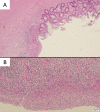A Rare Case of COVID-19 Infection Leading to Colonic Stricture: Case Report and Review of Literature
- PMID: 35989841
- PMCID: PMC9389142
- DOI: 10.7759/cureus.27043
A Rare Case of COVID-19 Infection Leading to Colonic Stricture: Case Report and Review of Literature
Abstract
Coronavirus disease 2019 (COVID-19) predominantly targets the respiratory tract; despite gastrointestinal (GI) symptoms that may present in many patients, colonic strictures in coronavirus disease (COVID-19) patients are extremely rare and, to our knowledge, have never been reported. We, herein, present a case of a 59-year-old lady who developed intestinal obstruction due to colonic strictures shortly after recovering from complicated COVID-19 pneumonia. Ultimately, she underwent laparoscopic subtotal colectomy with ileorectal anastomosis. After a long recovery period, she was discharged in good status. It has been more than two years since COVID-19 was declared as a pandemic by the World Health Organization. Infected individuals have highly variable clinical manifestations, yet the pathogenesis, diagnosis and ideal management of each of these complications is not well described in literature.
Keywords: colon; constipation; covid-19; intestinal obstruction; sars-cov-2; strictures.
Copyright © 2022, Yousaf et al.
Conflict of interest statement
The authors have declared that no competing interests exist.
Figures






Similar articles
-
Colonic Gangrene: A Sequela of Coronavirus Disease 2019.Cureus. 2021 Apr 26;13(4):e14687. doi: 10.7759/cureus.14687. Cureus. 2021. PMID: 34055531 Free PMC article.
-
Preservation of superior rectal artery in laparoscopically assisted subtotal colectomy with ileorectal anastomosis for slow transit constipation.World J Gastroenterol. 2021 Jun 14;27(22):3121-3129. doi: 10.3748/wjg.v27.i22.3121. World J Gastroenterol. 2021. PMID: 34168413 Free PMC article.
-
Sigmoid colon perforation in a SARS-CoV-2 positive neonate: a uniqueness report and a brief review.BMC Pediatr. 2022 Jun 3;22(1):327. doi: 10.1186/s12887-022-03392-1. BMC Pediatr. 2022. PMID: 35659271 Free PMC article. Review.
-
Long-term results of subtotal colectomy and evidence of noncolonic involvement in patients with idiopathic slow-transit constipation.Scand J Gastroenterol. 1996 Nov;31(11):1083-91. doi: 10.3109/00365529609036891. Scand J Gastroenterol. 1996. PMID: 8938901
-
Atypical Manifestations of Severe Acute Respiratory Syndrome Coronavirus 2 Infection in Children: A Systematic Review.Curr Pediatr Rev. 2021;17(3):162-171. doi: 10.2174/1573396317666210406153302. Curr Pediatr Rev. 2021. PMID: 33823780
Cited by
-
Independent Predictors and Causes of Thirty-Day Gastrointestinal Readmissions Following COVID-19-Related Hospitalizations: Analysis of the National Readmission Database.Gastroenterology Res. 2023 Jun;16(3):157-164. doi: 10.14740/gr1623. Epub 2023 Jun 11. Gastroenterology Res. 2023. PMID: 37351083 Free PMC article.
References
Publication types
LinkOut - more resources
Full Text Sources
Miscellaneous
